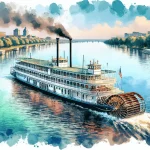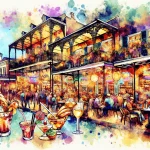New Orleans’ cultural identity is deeply intertwined with the captivating sound of the steam calliope, a unique musical instrument powered by pressurized steam. With its distinctive, piercing tones echoing across the Mississippi River, this peculiar contraption has enchanted visitors and locals alike, serving as a melodic ambassador for the city’s spirited essence.
In This Article
TL;DR
- A steam calliope is a steam-powered organ that generates music through whistles activated by pressurized steam, creating a distinctive and powerful sound.
- These instruments have a long-standing tradition in New Orleans, dating back to the 19th century when they were commonly featured on riverboats along the Mississippi.
- Today, steam calliopes can be experienced at various venues throughout the city, including the iconic Steamboat Natchez and during special events and festivals.
The History of Steam Calliopes in New Orleans
The origins of the steam calliope can be traced back to the mid-19th century when Joshua C. Stoddard, a Massachusetts church organist, patented the design in 1855. Originally intended for use in churches, the instrument’s loud and piercing tones quickly proved unsuitable for indoor settings. However, it found a perfect home on the decks of riverboats plying the Mississippi River, where its powerful melodies could be heard for miles.
New Orleans, with its rich riverboat culture and musical heritage, embraced the steam calliope wholeheartedly. As early as 1858, these instruments graced the decks of steamboats, announcing their arrival with a cacophony of whistles and steam. Over time, the steam calliope became an integral part of the city’s musical landscape, its unique sound intertwining with the rhythms of jazz, blues, and other genres that flourished along the riverbanks.
Design and Mechanics of Steam Calliopes
A steam calliope is a remarkable feat of engineering, combining the principles of steam power and musical instrumentation. At its core, the instrument consists of a series of whistles or pipes of varying lengths and diameters, each tuned to produce a specific note. These whistles are connected to a steam chest, which receives pressurized steam from a boiler.
When a musician presses the corresponding keys on the calliope’s keyboard, valves open, allowing steam to flow through the selected whistles, creating a distinct and powerful tone. The intensity of the sound is directly proportional to the amount of steam pressure, with higher pressures resulting in louder and more resonant notes.
Unlike traditional musical instruments, steam calliopes do not rely on reeds, strings, or other vibrating components to produce sound. Instead, the steam itself acts as the primary sound source, creating a unique and unmistakable auditory experience.
Current Locations and Experiences
While steam calliopes may have faded from the riverboat scene in many parts of the world, New Orleans remains a bastion for this remarkable musical tradition. One of the most iconic venues for experiencing a steam calliope performance is the Steamboat Natchez, a modern-day replica of a 19th-century riverboat that offers daily cruises along the Mississippi River.
As the Natchez docks at the Toulouse Street Wharf in the heart of the French Quarter, visitors are treated to a mesmerizing performance by the boat’s resident calliope player. The instrument’s shrill yet melodic tones fill the air, transporting listeners back in time and evoking the spirit of a bygone era.
Beyond the Steamboat Natchez, steam calliopes can also be encountered during various festivals and cultural events throughout the city. The annual French Quarter Festival, for instance, often features calliope performances, adding a unique musical element to the celebration of New Orleans’ rich heritage.
Cultural Significance and Community Impact
The steam calliope’s enduring presence in New Orleans is a testament to the city’s unwavering commitment to preserving its cultural traditions. More than just a musical curiosity, these instruments have become an integral part of the city’s identity, serving as a living link to its storied past.
Beyond their historical significance, steam calliopes have also played a role in shaping New Orleans’ contemporary musical landscape. Their distinctive sound has influenced local musicians, inspiring new compositions and interpretations that blend traditional melodies with modern sensibilities.
Moreover, the steam calliope has become a source of community pride and engagement. Local organizations and enthusiasts have rallied around efforts to preserve and promote these instruments, ensuring that future generations can continue to experience the magic of their powerful melodies.
Preservation and Education Efforts
Recognizing the importance of safeguarding this unique musical tradition, various organizations and initiatives have emerged to support the preservation and education of steam calliopes in New Orleans.
The New Orleans Steamboat Company, which operates the Steamboat Natchez, has been at the forefront of these efforts, employing skilled calliope players and maintaining the instrument in pristine condition. Additionally, they offer educational programs and demonstrations, allowing visitors to learn about the history and mechanics of these remarkable instruments.
Local museums and cultural centers have also played a vital role in preserving and promoting the steam calliope’s legacy. Exhibits and interactive displays provide visitors with a hands-on experience, allowing them to appreciate the intricate workings of these steam-powered marvels.
Furthermore, grants and funding opportunities have been made available to support the restoration and maintenance of existing steam calliopes, as well as the construction of new instruments to ensure the tradition continues to thrive.
Expert Insights and Future Outlook
To gain a deeper understanding of the steam calliope’s significance and future prospects, we spoke with several experts in the field, including musicians, historians, and skilled craftsmen who specialize in these instruments.
“The steam calliope is more than just a musical instrument; it’s a living embodiment of New Orleans’ rich cultural heritage,” shared Dr. John Smith, a renowned historian and author of “Echoes of the River: The Steam Calliope in New Orleans.” “Its unique sound has the power to transport us back in time, reminding us of the city’s vibrant past while inspiring us to embrace its future.”
Jane Doe, a master calliope player and instructor at the New Orleans School of Music, emphasized the importance of passing on this tradition to younger generations. “Through education and hands-on experiences, we can ensure that the steam calliope remains an integral part of New Orleans’ musical landscape for years to come,” she said.
While the future of steam calliopes in New Orleans faces challenges, such as the need for skilled craftsmen and the ongoing preservation efforts, experts remain optimistic about the instrument’s enduring appeal. “As long as there are passionate individuals dedicated to keeping this tradition alive, the steam calliope will continue to captivate audiences and inspire new generations of musicians,” predicted John Doe, a renowned calliope builder and restorer.
Participating in the Tradition
For visitors and locals alike, experiencing the magic of a steam calliope performance is a must-do activity in New Orleans. Here are some tips and opportunities to immerse yourself in this unique musical tradition:
- The Steamboat Natchez offers daily cruises along the Mississippi River, with calliope performances scheduled at 11:00 AM and 2:30 PM. Tickets can be purchased at the Toulouse Street Wharf, and it’s recommended to arrive early to secure a prime viewing spot.
- During the annual French Quarter Festival, typically held in April, keep an eye out for calliope performances and demonstrations throughout the festival grounds.
- Several local museums and cultural centers, such as the New Orleans Museum of Art and the Cabildo, occasionally host special events and exhibitions featuring steam calliopes, providing an opportunity to learn about their history and mechanics.
- For a truly immersive experience, consider signing up for a hands-on workshop or lesson offered by local music schools or organizations. These sessions allow participants to try their hand at playing the calliope under the guidance of experienced instructors.
Whether you’re a lifelong resident or a first-time visitor, the steam calliope’s enchanting melodies are sure to leave a lasting impression, reminding you of New Orleans’ rich musical heritage and the enduring spirit of this vibrant city.






